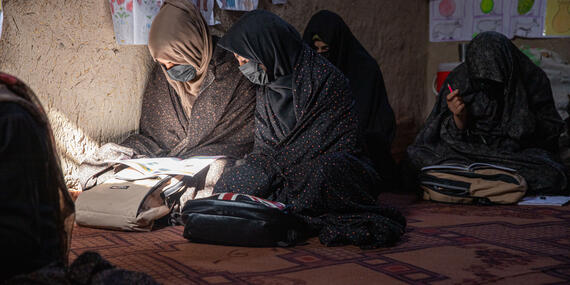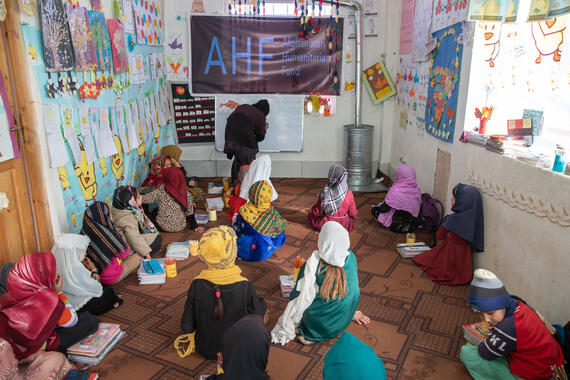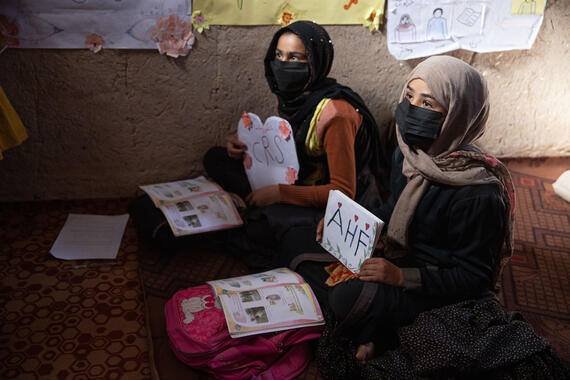Afghanistan Humanitarian Fund: 10 Years on the front lines

By Aria Abawi
Over the past decade, the Afghanistan Humanitarian Fund has emerged as a lifeline for countless people amid the country's ongoing challenges.
Strategic and reliable
Launched in 2014, the Afghanistan Humanitarian Fund (AHF) has become one of OCHA's leading initiatives, exceeding an incredible US$1 billion milestone by 2024.
Through targeted support, the fund is now a beacon of hope for people grappling with the aftermath of conflict, natural disasters and displacement. In the past decade, the AHF has supported more local non-governmental organizations (NGOs) and women-led organizations to empower and enable the country’s most-affected communities. Afghan women now face harsh restrictions that limit their participation in public life, including in humanitarian efforts.

Sustaining hope
Afghanistan has suffered from persistent conflict, underdevelopment, poverty and, more recently, COVID-19. This led to yet another crisis: hunger.
An Integrated Food Security Phase Classification analysis from April 2021 revealed that over 14 million people – more than a third of the population – faced acute food insecurity, prompting urgent action. In early 2021, the most vulnerable households received nutrition-sensitive food packages. The AHF funded food security and agriculture projects for 1.2 million people across the country.
Notably, children as young as this 11-year-old girl help to collect their family’s food rations at a World Food Programme (WFP) distribution point in Kandahar Province. Each provision offers sustenance, but also compassion, humanity and resilience.

Creating a safe haven
Created by War Child UK and funded by the AHF, this child-friendly space in Herat Province is a haven of hope for 10-year-old Salma. This refuge is not just a place to practice handwriting, but a place for Salma to learn, play and embrace childhood under the loving care of community facilitators and peers.
Tailored for girls like Salma, child-friendly spaces shield against exploitation in conflict zones and provide a safe and protective environment in which children exposed to trauma can receive psychosocial support and counselling, leaving a lasting positive impact on the mental well-being of thousands of communities.
Over the past decade, the AHF has funded dozens of such sanctuaries across Afghanistan.

Sakena Yacoobi Hospital
Sakena Yacoobi Hospital in Herat Province is testament to the resilience and empowerment of Afghan women, despite the challenges they face.
Staffed entirely by women, this sanctuary provides essential health-care services tailored to the unique needs of women and children. From antenatal care to mental health services, the hospital, funded by AHF and the World Health Organization (WHO), is a lifeline for between 5,000 and 6,000 patients each month.
Dr. Homa Niksiar, the hospital's Director, embodies the spirit of compassionate care, earning the community’s trust and gratitude through her unwavering commitment to quality health care.

Addressing water scarcity
In the face of persistent droughts and water scarcity, AHF-funded projects implemented by World Vision International have brought tangible relief to communities in provinces such as Badghis and Herat. By establishing solar-powered water systems and rehabilitating infrastructure, these initiatives have addressed immediate hydration needs but also promoted better hygiene practices, reducing waterborne diseases.
In a region where water scarcity looms large, the AHF's efforts offer hope and tangible progress, fostering resilience and paving the way for a healthier Afghanistan.

Making aid accessible for women
In Afghanistan, the role of female aid workers in humanitarian response remains critical. In Badghis Province, they manage the cash distributions to female-headed households by creating a safe and accessible space for recipients.
Among those benefiting from this critical support is 55-year-old Gul Jan, who expressed profound gratitude: “I came here today to receive my cash assistance. My grandchildren will be so happy, as I will buy them good food and clothes.”
These AHF-supported initiatives are a lifeline for vulnerable families, providing essential help and fostering empowerment in communities across Afghanistan.
Localized aid
The AHF became the first Country-Based Pooled Fund to launch a dedicated “localization allocation” of US$12.9 million in July 2023. It aims to promote local and national NGOs. AHF-supported initiatives, such as the Bakhtar Development Network's rural clinic, bring essential medical services closer to communities in need.
Women living in remote villages have seen their access to quality health care transformed, thanks to AHF-supported efforts that prioritize the well-being of vulnerable populations.
Nawroz is one of those women. She explained: “I deeply appreciate the compassionate and professional care I received at the hospital. It’s a necessity for women and their children in rural areas.”

2024: AHF Outlook
The AHF is committed to serving Afghanistan’s most vulnerable populations, working with partners and donors. But with needs in the country now at a record high, the AHF urgently requires sustained contributions to provide proactive support to communities in need.
Efforts will continue to broaden the donor base for early and reliable funding, with advocacy led by the Humanitarian Coordinator and OCHA.

